Blue flowers name are some of the most beautiful and unique types of flowers in the world. There are many different names for blue flowers, some of the most popular of which include bluebells, forget-me-nots, blue poppies, blue hydrangeas, and blue asters. Bluebells are small, delicate flowers that grow in clusters and can be found in wooded areas.
They are also known as harebells or bellflowers. Forget-me-nots are small, dainty flowers that symbolize true love and loyalty. They are often used in wedding bouquets and centerpieces. Blue poppies are rare and exotic and are often seen as a symbol of success and achievement.
Blue hydrangeas are popular in gardens and are known for their big, showy blooms. They are often seen as a symbol of gratitude and understanding. Blue asters are star-shaped flowers that are often used in fall floral arrangements. They represent patience and elegance. With so many different types of blue flowers, it’s easy to find one that suits your personal taste and style.
Blue Flowers Name
Globe Thistle Echinops Ritro
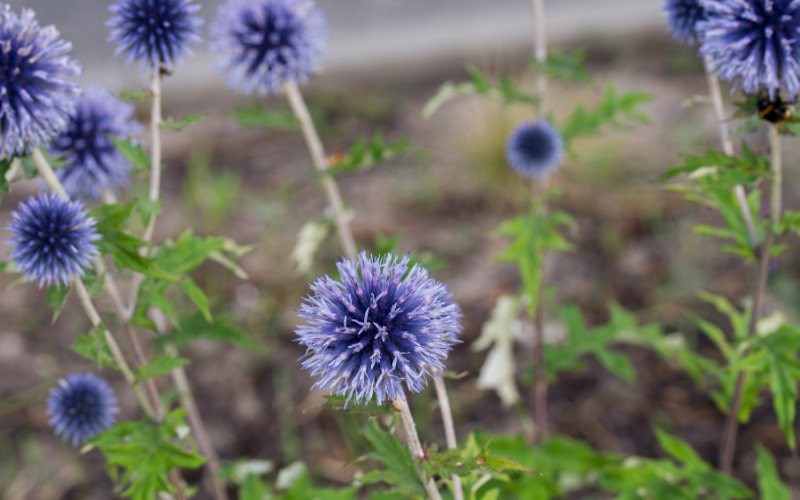
Globe Thistle, scientifically known as Echinops ritro, is a blooming perennial plant in the Asteraceae family. Globe Thistle grows well in full sun to moderate shade and in well-drained soil. Once established, it is a hardy plant that can survive a wide range of soil types and is highly drought-tolerant.
Globe Thistle is a low-maintenance plant in general. It is pest and disease resistant and does not require frequent irrigation. Removing wasted flower heads encourages more blooms and prevents self-seeding.
| Scientific Name | Echinops ritro |
| Native Range | Southern and Eastern Europe (from Spain east to Turkey, Ukraine, and Belarus), and Western Asia |
| Flowering Season | Mid to Summer |
Iris Sibirica
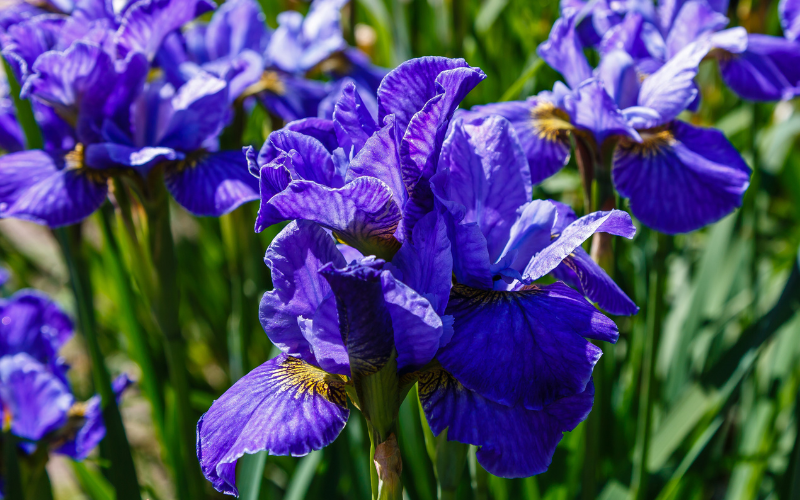
Iris sibirica, commonly known as Siberian Iris, is a perennial flowering plant belonging to the family Iridaceae. Siberian Iris grows in clumps and has long, erect stems that bear the flowers. The foliage is made up of long, slender, grass-like leaves that provide a backdrop for the blossoms.
Iris flowers, including Siberian Iris, are often associated with messages of faith, wisdom, and eloquence. They have a rich history and are valued for their beauty and symbolism.
| Scientific Name | Iris sibirica |
| Native Range | Europe and Central Asia |
| Flowering Season | Late spring to early summer |
Periwinkle Corydalis Flexuosa
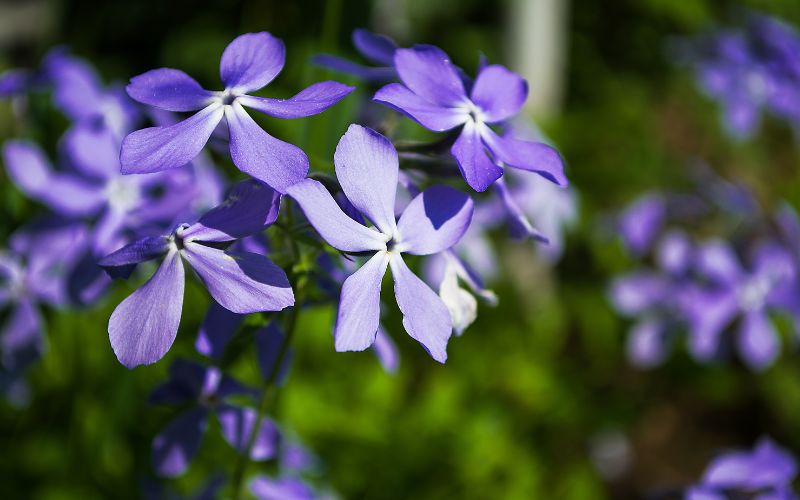
The Periwinkle Corydalis flexuosa, commonly known as the Chinese Corydalis or Blue Corydalis, is a perennial blooming plant endemic to Asia. It is a member of the Papaveraceae family. The Periwinkle Corydalis flexuosa is a low-growing plant that grows to around 20-30 centimeters (8-12 inches) in height.
This plant prefers partial shade to full shade, making it a good choice for woodland gardens or shaded areas. It thrives in moist, well-drained soil that is rich in organic matter. It can tolerate a range of soil types, including loam, clay, and sandy soil.
| Scientific Name | Corydalis flexuosa |
| Native Range | East Asia |
| Flowering Season | Spring and early summer |
Gentiana Verna
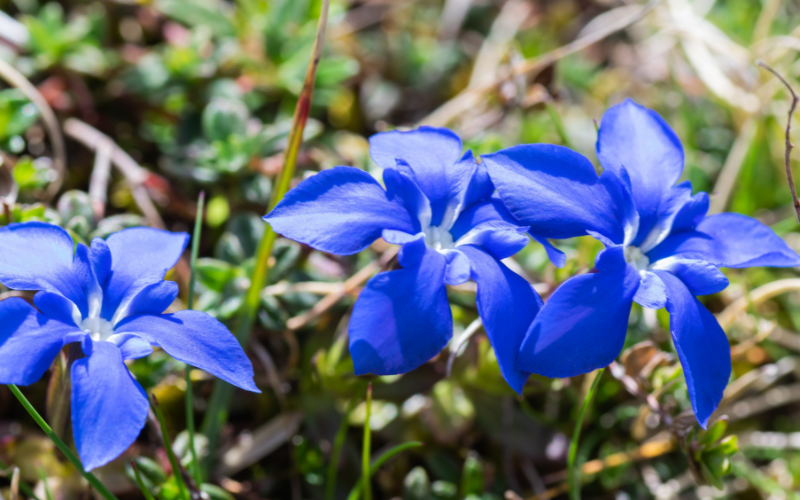
Gentians (Gentiana verna) are a type of perennial flowering plant that is recognized for its colorful and beautiful blossoms. Gentiana verna is one of the most commonly encountered Gentiana species.
Gentiana verna requires special care to stay healthy and flowering. Because these plants demand steady hydration, it is critical to water them on a regular basis, especially during dry spells. To ensure proper drainage, utilize a well-draining soil mix or amend heavy clay soils. Gentiana verna is grown largely for its decorative appeal. It is frequently used as a border plant in rock gardens, alpine gardens, and as a border plant.
| Scientific Name | Gentiana verna |
| Native Range | Central and southern Europe from North-west Spain and Morocco eastwards to the Caucasus and the mountains of central Asia |
| Flowering Season | Late spring to early summer |
Perennial Geraniums
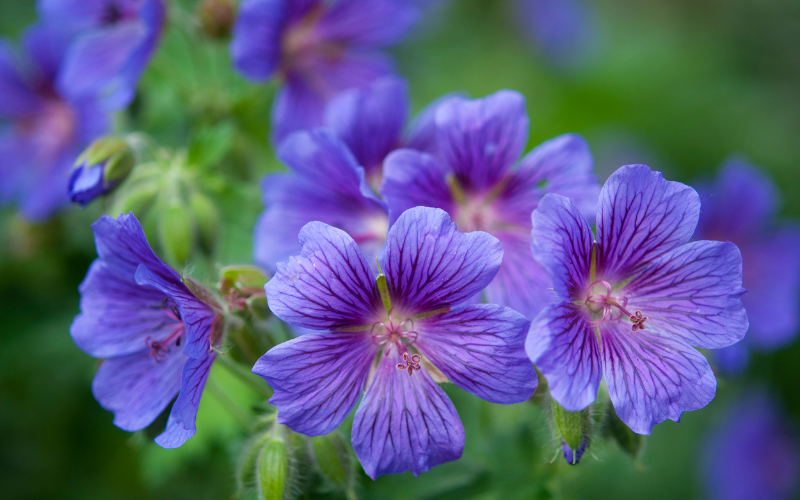
The Perennial Geranium, also known as Geranium, is a popular flowering plant that belongs to the Geraniaceae family. It is different from the commonly known garden plant called Pelargonium, which is also referred to as geranium.
Perennial Geraniums are herbaceous plants that range in size from low-growing ground covers to larger clump-forming variants. They have palmately lobed or split green leaves, however, some variants have bronze or variegated foliage.
| Scientific Name | Geranium bohemicum |
| Native Range | Europe, North America, and parts of Asia |
| Flowering Season | Late spring to early fall |
Clematis

Clematis is a plant genus of the Ranunculaceae family, also known as the buttercup family. The Clematis genus contains many species and cultivars that are well-known for their beautiful and colorful flowers.
The size, shape, and color of clematis blossoms vary depending on the species or cultivar. Flowers might be little and bell-shaped, or huge and star-shaped. They normally have four to eight petals that are either flat or ruffled. Clematis plants grow well in a variety of settings, but they prefer a sunny location with at least six hours of sunlight every day. Some types, however, may withstand mild shade.
| Scientific Name | Clematis |
| Native Range | Japan, China, Europe and North America |
| Flowering Season | Early summer to early fall |
Bellflower Campanula
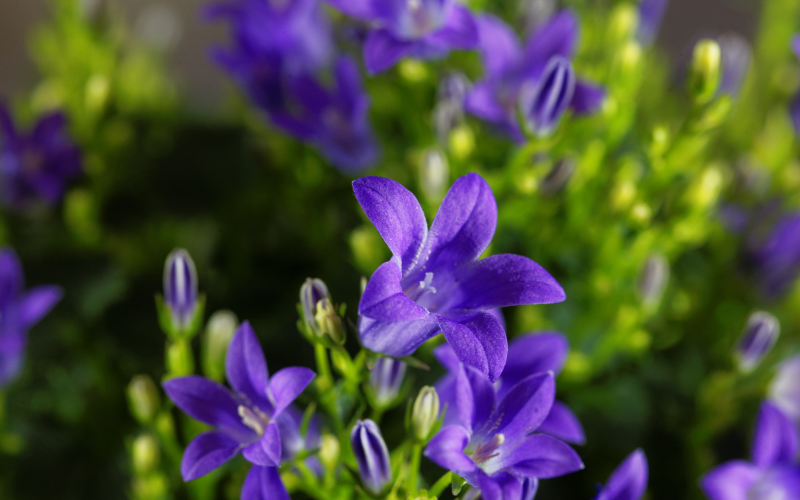
The Bellflower, scientifically known as Campanula, is a diverse genus of flowering plants in the family Campanulaceae. With a wide range of species and cultivars, Bellflowers are cherished for their bell-shaped flowers and charming appearance.
Campanula blooms come in a range of shapes, sizes, and colors, but they always have distinctive bell-shaped blossoms that give the plant its name. The flowers can be single or grouped, with five fused petals forming a bell or cup shape.
| Scientific Name | Campanula |
| Native Range | Britain and Japan |
| Flowering Season | Summer |
Gentiana Saponaria
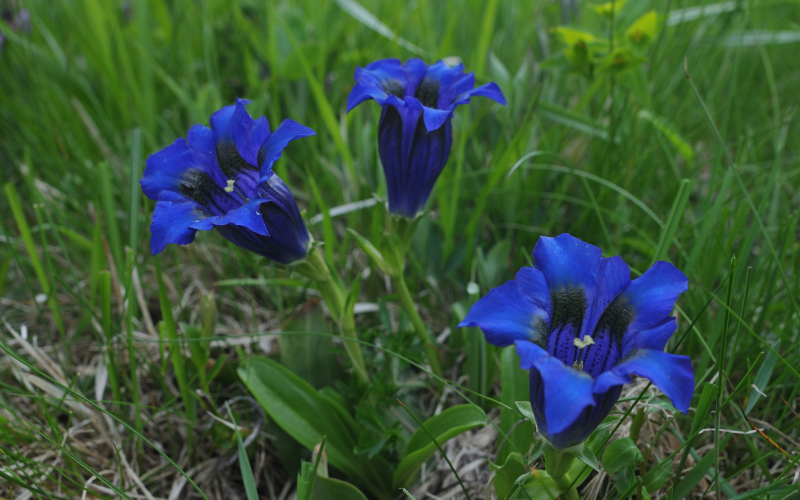
Gentiana saponaria, commonly known as Soapwort Gentian or Soapwort Bitterroot, is a species of flowering plant in the Gentianaceae family. It is a perennial herbaceous plant native to mountainous regions of Europe. Gentiana saponaria requires appropriate moisture, especially during dry periods. Watering on a regular basis is required to keep the soil hydrated.
Mulching around the base of the plant can aid in moisture retention and temperature regulation. Gentiana saponaria is grown primarily for its decorative appeal. Its lovely blue flowers make it a favorite for rock gardens, alpine landscapes, and mixed perennial beds. Pollinators such as bees and butterflies are drawn to the plant.
| Scientific Name | Gentiana saponaria |
| Native Range | Europe |
| Flowering Season | Late summer to early autumn |
Siberian Squill
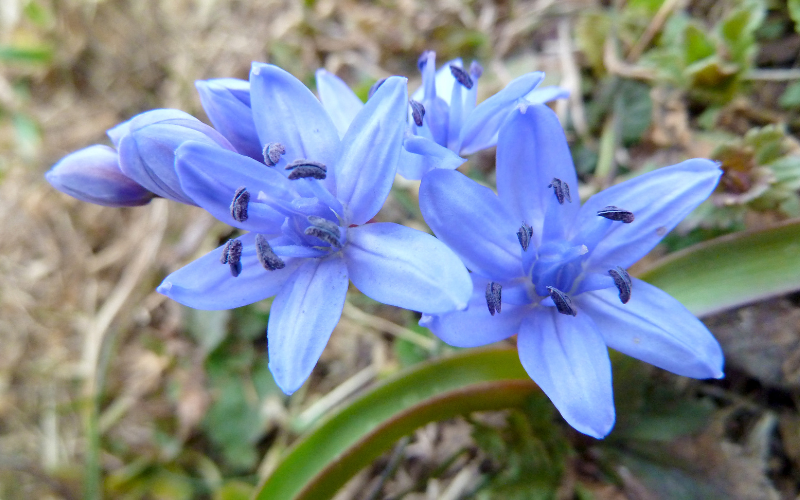
The Siberian Squill, scientifically known as Scilla siberica, is a small bulbous perennial plant that belongs to the family Asparagaceae. It is native to Eastern Europe and Western Asia. Siberian Squill plants produce basal rosettes of narrow, strap-like leaves that emerge from small bulbs.
The flowers of Siberian Squill are star-shaped and pendulous, typically measuring about 1 to 1.5 centimeters (0.4 to 0.6 inches) in diameter. Siberian Squill plants produce basal rosettes of narrow, strap-like leaves that emerge from small bulbs. The flowers of Siberian Squill are star-shaped and pendulous, typically measuring about 1 to 1.5 centimeters (0.4 to 0.6 inches) in diameter.
| Scientific Name | Scilla Siberica |
| Native Range | Southwestern Russia, the Caucasus, and Turkey |
| Flowering Season | Spring |
Columbine
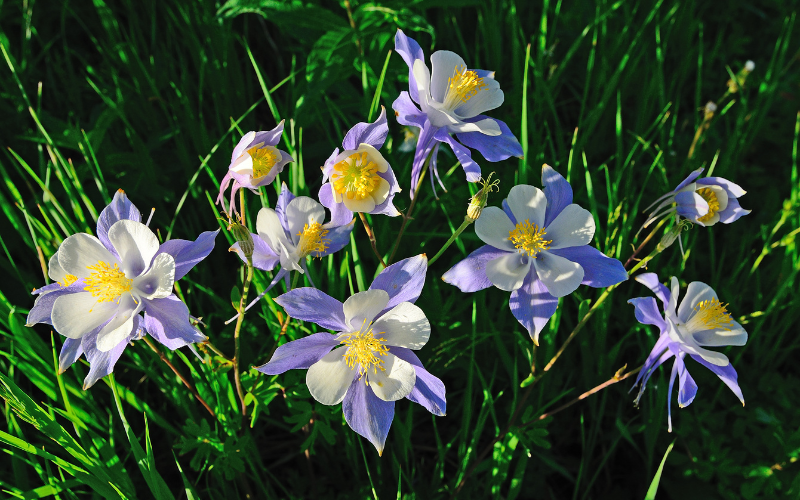
Columbine, scientifically known as Aquilegia, is a flowering plant genus in the Ranunculaceae family. Columbines are recognized for their exquisite blossoms that come in a variety of colors and shapes. Columbine flowers are distinguished by their spurred petals, which give them a striking appearance.
The blooms have five petals that create an outer ring and can be elongated, rounded, or have prominent spurs at the base. Columbines grow best in well-drained soil and like medium to full light, while some kinds can take more shade. They are adaptable plants that can grow in a wide range of soil conditions, from sandy to clayey.
| Scientific Name | Aquilegia |
| Native Range | North America, Europe, and Asia |
| Flowering Season | Mid-spring to early summer |
Azure Aster
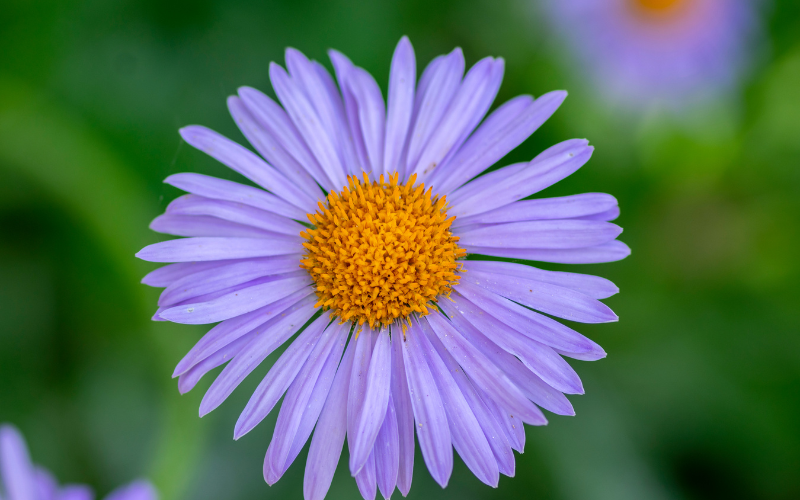
The Azure Asteris a beautiful flower. The Azure Aster is native to North America. The Azure Aster blooms in late summer and early fall.
Its name “Azure,” derives from the stunning shade of blue that adorns its petals, resembling the clear blue skies on a sunny day. the Azure Aster is a captivating and valuable addition to any floral display.
| Scientific Name | Symphyotrichum oolentangiense |
| Native Range | Eastern North America |
| Flowering Season | Late summer to fall |
Blue Flax
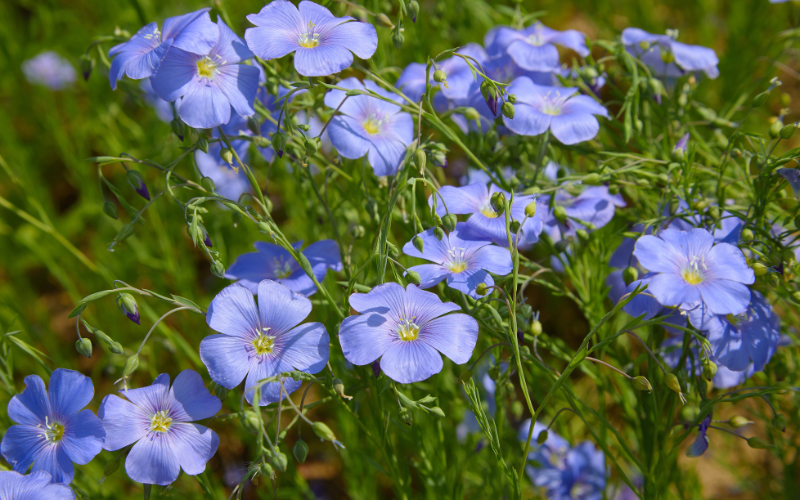
The Blue Flax is a stunningly beautiful flower. It is native to western North America. The stems are slender and typically reach heights of 1 to 2 feet (30 to 60 cm).
The flowers are cup-shaped and have five petals that are often slightly crinkled or ruffled at the edges. Blue Flax is associated with various meanings, including purity, grace, and remembrance.
| Scientific Name | Linum lewisii |
| Native Range | Western North America from Alaska south to Baja California, and from the Pacific Coast east to the Mississippi River |
| Flowering Season | Late spring, last through midsummer, |
Blue Orchid
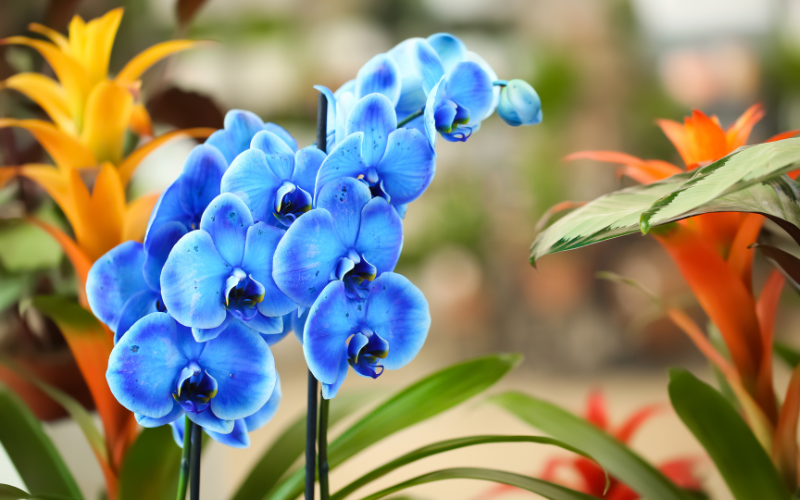
The blue orchid flower is a rare and captivating beauty. It is often considered a symbol of rarity and uniqueness. The blue orchid stands out with its striking vibrant blue petals. The alluring shade of blue is truly mesmerizing, evoking a sense of tranquility and calmness.
The blue orchid is a true testament to the wonders of nature, reminding us of the endless possibilities and remarkable diversity found in the botanical world.
| Scientific Name | Vanda coerulea |
| Native Range | Eastern Himalayas, northeast India, and in Asia in Myanmar, Thailand, Laos, Cambodia, and Southern China |
| Flowering Season | Early autumn |
Blue Star
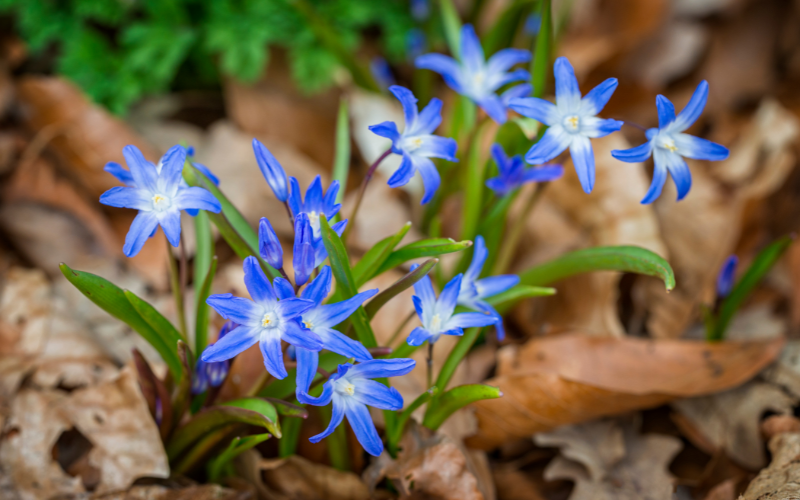
The Blue Star Flower is a stunning perennial plant. It is scientifically known as Amsonia tabernaemontana. It is native to North America. The most notable feature of the Blue Star Flower is its star-shaped flowers. The flowers have five narrow, pointed petals that radiate outward, resembling a star.
It prefers full sun to partial shade and well-draining soil. Blue Star Flower is often planted in flower beds, borders, and mixed perennial plantings. It is relatively low-maintenance and can tolerate a range of soil conditions.
| Scientific Name | Amsonia |
| Native Range | Southern and Southeastern United States, and Northern Mexico |
| Flowering Season | Late Spring – Early Summer |
Bluecrown Passionflower
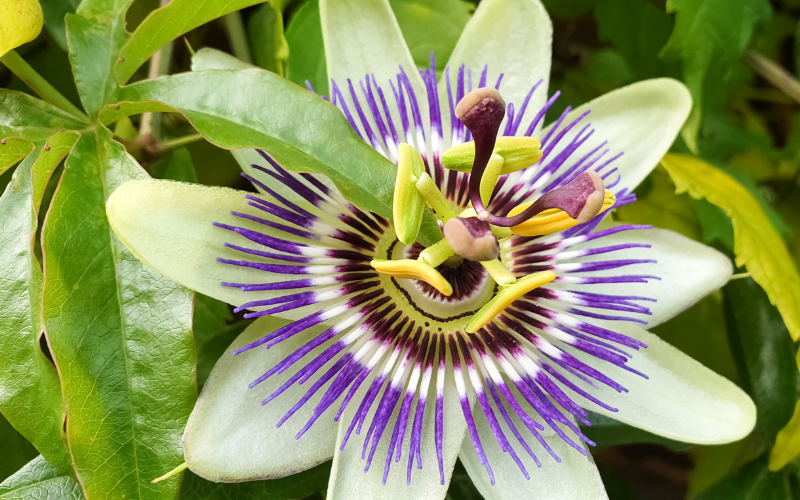
The Bluecrown Passionflower is a beautiful plant. It is native to South America. The flowers are large, measuring about 3 to 4 inches (8 to 10 cm) in diameter, and have a unique structure.
They have a central crown of blue, purple, or lavender filaments, which gives rise to the common names “Blue Passionflower” or “Bluecrown Passionflower.” It prefers a sunny location with well-draining soil.
| Scientific Name | Passiflora caerulea |
| Native Range | South America (southern Brazil, Argentina, Paraguay and Uruguay) |
| Flowering Season | Late spring to early autumn |
Chicory
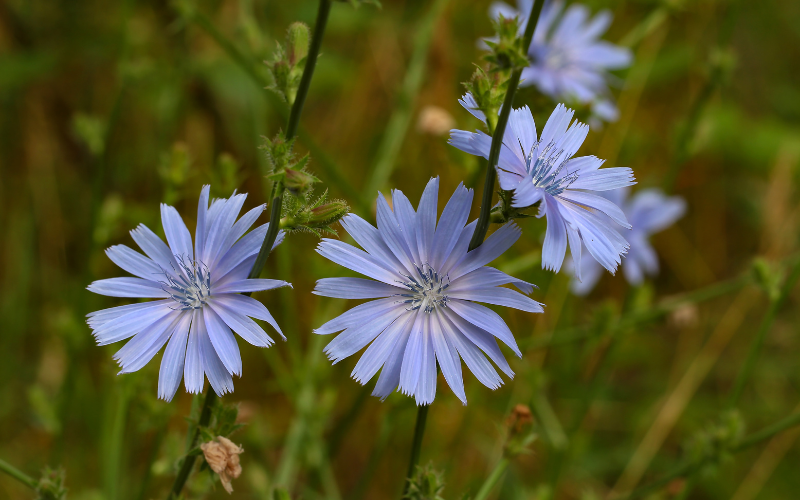
The Chicory is a beautiful flower. It is scientifically known as Cichorium intybus. It is native to Europe. The plant grows as a rosette of basal leaves and sends up tall, slender stems that can reach heights of up to 3 to 5 feet (about 1 to 1.5 meters).
The most distinctive feature of chicory is its bright blue flowers. the chicory plant is often roasted and ground to produce a coffee substitute that is both caffeine-free and rich in antioxidants.
| Scientific Name | Cichorium intybus |
| Native Range | Western Asia, North Africa, and Europe |
| Flowering Season | Summer |
Cornflower
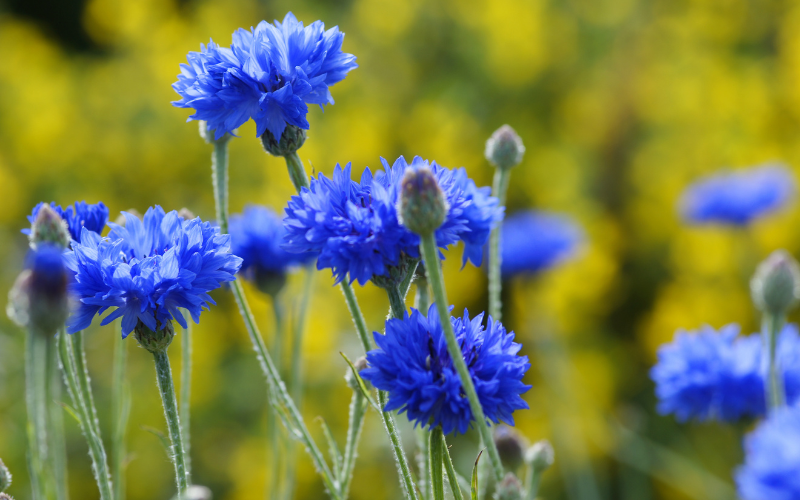
The Cornflower is a charming annual flowering plant in the family Asteraceae. It is scientifically known as Centaurea cyanus. It is native to Europe. Cornflower is famous for its striking blue flowers and is also known by other names, such as Bachelor’s Button and Bluebottle.
Cornflower plants grow to a height of about 1 to 3 feet (30 to 90 cm). The flowers have a beautiful, vivid blue color, but they can also be found in shades of pink, white, and purple through selective breeding.
| Scientific Name | Centaurea cyanus |
| Native Range | Europe, North America |
| Flowering Season | Late Spring and Early Summer |
Desert Bluebells
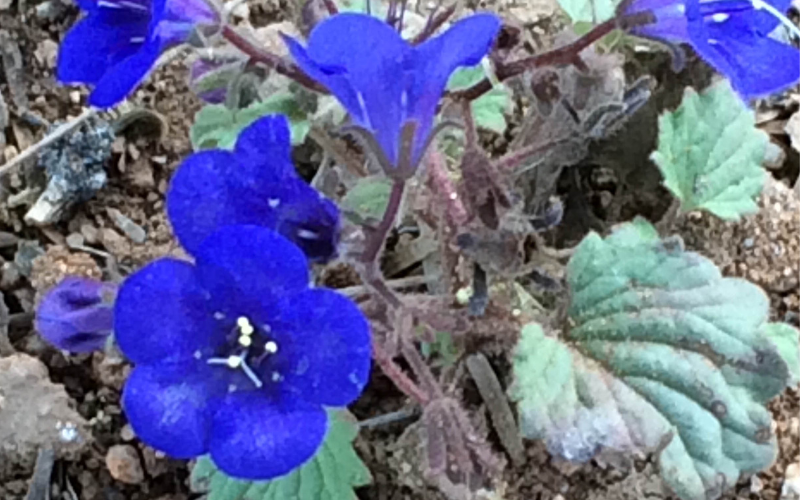
The Desert Bluebell is a beautiful wildflower. It is scientifically known as Phacelia campanularia. It is native to the southwestern United States and northern Mexico. It is a member of the Boraginaceae family. The Desert Bluebells bloom in the spring and early summer.
The stems are slender and covered with fine hairs, and they can reach heights of about 6 to 12 inches (15 to 30 cm). The most striking feature of Desert Bluebells is its vibrant blue bell-shaped flowers. T
| Scientific Name | Phacelia campanularia |
| Native Range | The Southwestern United States and Northern Mexico |
| Flowering Season | Late winter to spring |
Fairy Thimbles
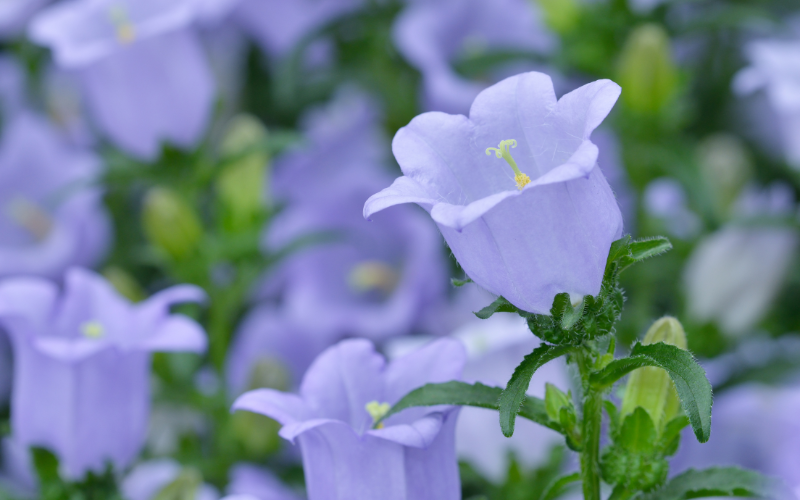
Fairy thimbles is a digitalis flower. It is also known as foxgloves. These tall, slender flowers with their delicate bell-shaped petals seem to have sprung right out of a fairytale.
Their vibrant colors, ranging from deep purples and pinks to pale whites and yellows, add a touch of magic to any garden or woodland setting. They bring a touch of whimsy and beauty to any garden or floral structure, serving as a reminder of the wonders of nature.
| Scientific Name | Campanula cochleariifolia |
| Native Range | Pyrenees, Alps, French Massif Central, and Carpathian Mountains of Central Europe |
| Flowering Season | Late spring to mid-summer |
Great Lobelia
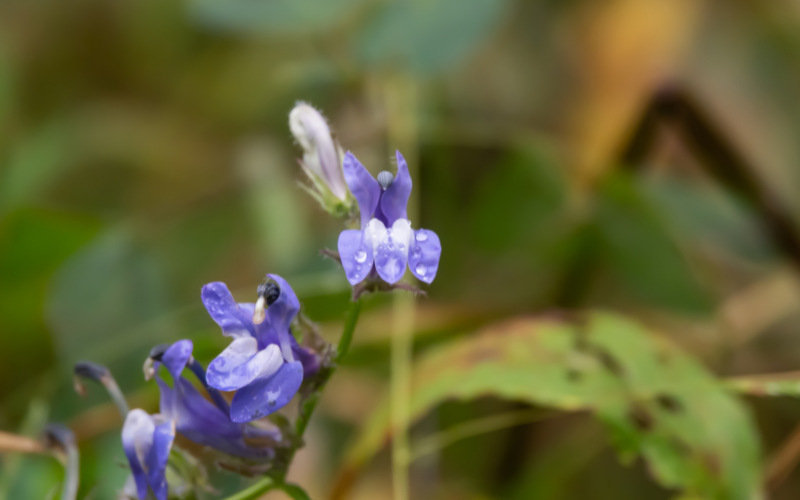
The Great Lobelia flower is a stunning and vibrant plant. It is scientifically known as Lobelia siphilitica. It is native to North America. Great Lobelia is a herbaceous perennial that typically grows to a height of about 2 to 3 feet (60 to 90 cm).
The most notable feature of the Great Lobelia is its vibrant blue flowers. Great Lobelia prefers moist to wet soil and partial to full sun exposure.
| Scientific Name | Lobelia siphilitica |
| Native Range | Maine to Georgia west to Texas, Colorado, Wyoming and the Dakotas. It is also known from Ontario and Manitoba |
| Flowering Season | Spring to Fall |
Speedwell
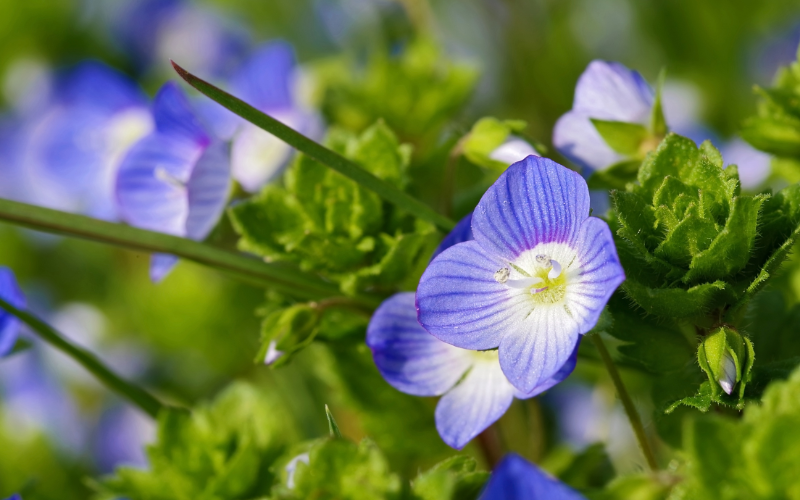
The Speedwell flower is stunning and vibrant. It is native to Europe. It is also known as Veronica. The Speedwell flower blooms in the spring and summer. The Speedwell flowers are typically small and have four-petaled, saucer-shaped blooms.
The flowers can come in various colors, including blue, purple, pink, and white, depending on the species or variety. It thrives in sunny locations with well-drained soil.
| Scientific Name | Veronica |
| Native Range | Asia and North America |
| Flowering Season | Late spring to early summer |
Triplet Lily
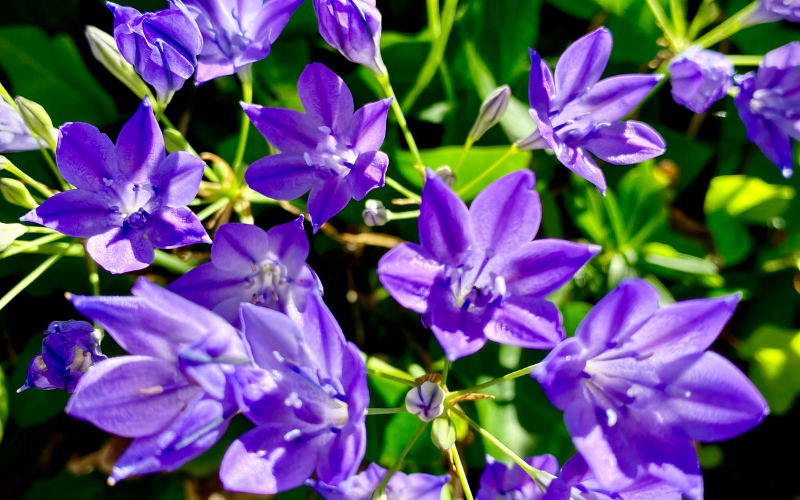
The triple Lily is a beautiful flower. It is also known as Triteleia laxa. This flower belongs to the lily family. It is native to the western parts of North America. It comes in shades of red, yellow, orange, and white.
They are star-shaped with six petal-like segments that can be various shades of blue, purple, or white, depending on the species or variety. They do well in full sun to partial shade and are generally hardy and easy to grow.
| Scientific Name | Triteleia laxa |
| Native Range | Western North America, from British Columbia south to California and east to Wyoming and Arizona, with one species in northwestern Mexico |
| Flowering Season | Summer |
Blue Hibiscus
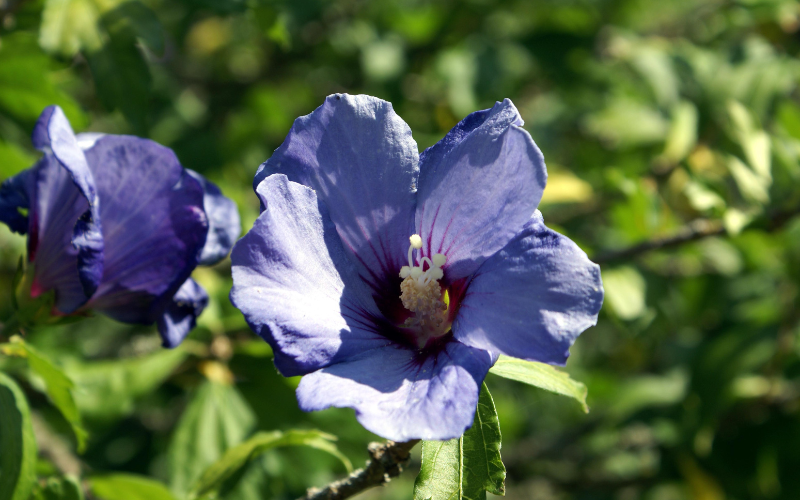
The Blue Hibiscus flower is a stunning flower. It is also known as the Alyogyne huegelii. It is native to Australia and thrives in warm, sunny climates.
The Blue Hibiscus is a relatively low-maintenance plant. It requires well-drained soil and full sunlight to flourish, and regular watering during dry spells.
| Scientific Name | Alyogyne huegelii |
| Native Range | Western Australia |
| Flowering Season | Spring |
Lungwort

The Lungwort is a stunning and unique flower. It is scientifically known as Pulmonaria. It is native to Europe. The Lungwort flowers are known for their changing hues, as they transition from pink to purple and eventually turn blue.
It prefers moist, well-draining soil and can thrive in woodland or woodland-like settings. Apart from its aesthetic appeal, lungwort also holds medicinal properties.
| Scientific Name | Pulmonaria |
| Native Range | North America, Europe, and Asia |
| Flowering Season | Spring |
Monkshood
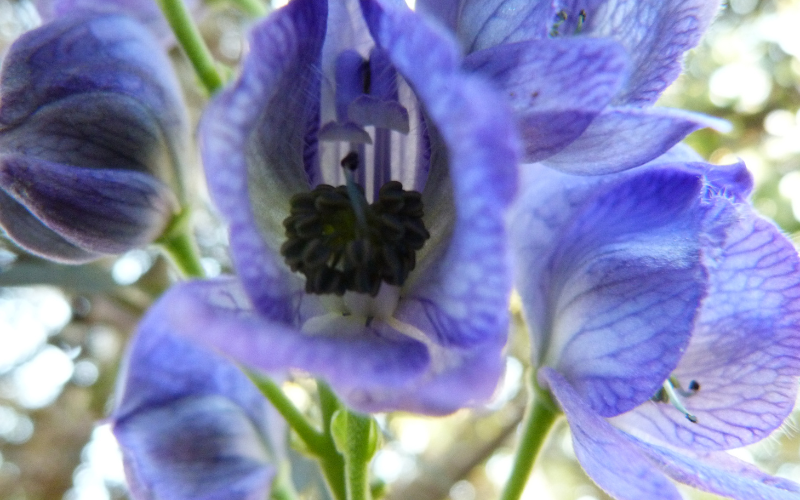
Monkshood is a mesmerizing flower. It is also known as Aconitum. It is native to mountainous regions of Europe and Asia. The flowers of Monkshood come in various colors, including shades of blue, purple, white, and yellow.
Monkshood prefers moist, well-draining soil and partial shade to full sun. They are hardy perennials that can be grown in a variety of climates.
| Scientific Name | Aconitum |
| Native Range | Western and Central Europe |
| Flowering Season | Late in the summer and fall |
Larkspur
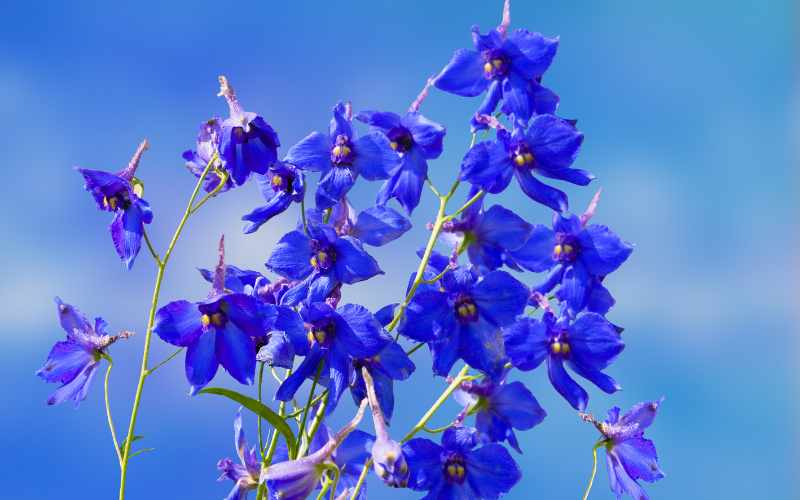
The Larkspur is a beautiful flower. It is native to the Northern Hemisphere. The flowers come in a wide range of colors, including shades of blue, purple, pink, white, and even some bi-color varieties.
The Larkspurs prefer well-draining soil and full sun. They are hardy perennials in some regions but are often grown as annuals or short-lived perennials in colder climates.
| Scientific Name | Delphinium |
| Native Range | British Columbia and Alberta south to California, Arizona and New Mexico, and as far east as South Dakota and Nebraska |
| Flowering Season | British Columbia and Alberta south to California, Arizona, and New Mexico, and as far east as South Dakota and Nebraska |
Hydrangea
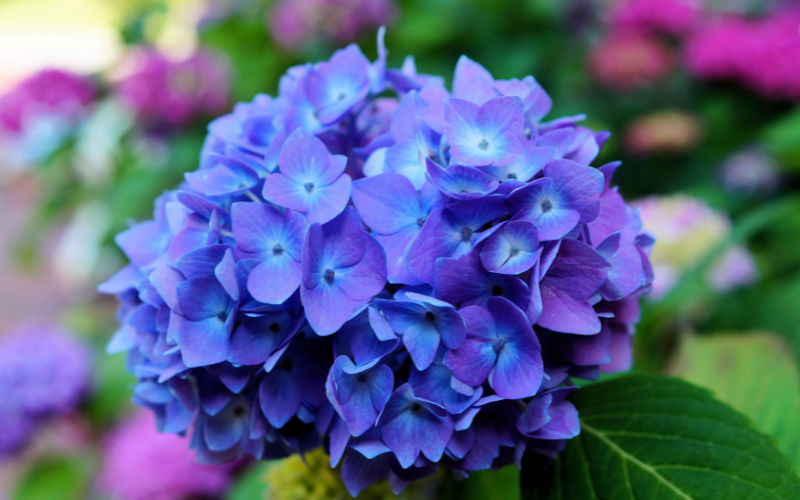
The hydrangea is a stunning and versatile flower. The flower clusters can be quite large and showy, ranging from 4 to 12 inches (10 to 30 cm) or more in diameter. The flower colors come in blue, purple, pink, red, and white.
The hydrangeas thrive in well-draining soil and prefer partial shade to filtered sunlight. The hydrangea boasts a long bloom period, ensuring a delightful display of colors throughout the summer months.
| Scientific Name | Hydrangea |
| Native Range | New York and Massachusetts west through Illinois and Missouri, south to Louisiana and Florida, and in Kansas and Oklahoma |
| Flowering Season | Mid-Spring through the late summer or early fall |
Hyacinth
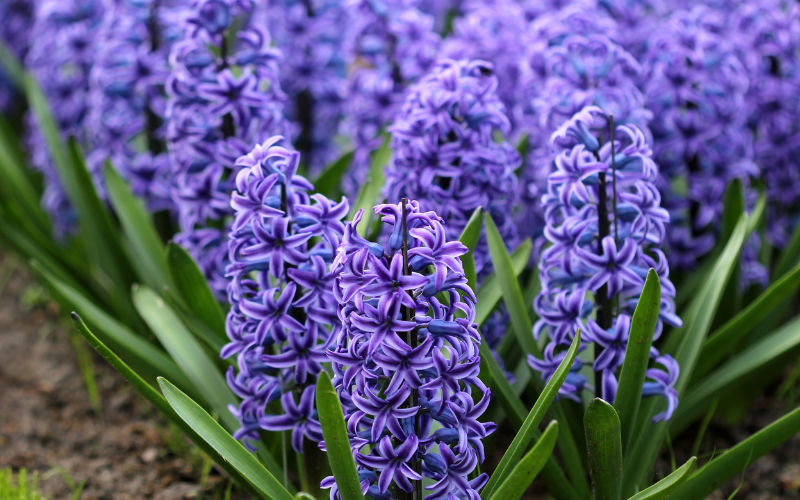
The Hyacinth is a beautiful flower. Hyacinths come in a variety of colors, including blue, pink, white, and purple, each with its own unique charm. One of the most delightful features of hyacinths is their strong, sweet fragrance.
Hyacinths are easy to grow from bulbs and prefer well-draining soil. They thrive in full sun to partial shade and require regular watering during their growth and blooming period.
| Scientific Name | Hyacinthus |
| Native Range | Turkey to north Israel, including Turkey, Turkmenistan, Iran, Iraq, Lebanon, Syria, and the region of Palestin |
| Flowering Season | Spring |
Glory-of-the-Snow
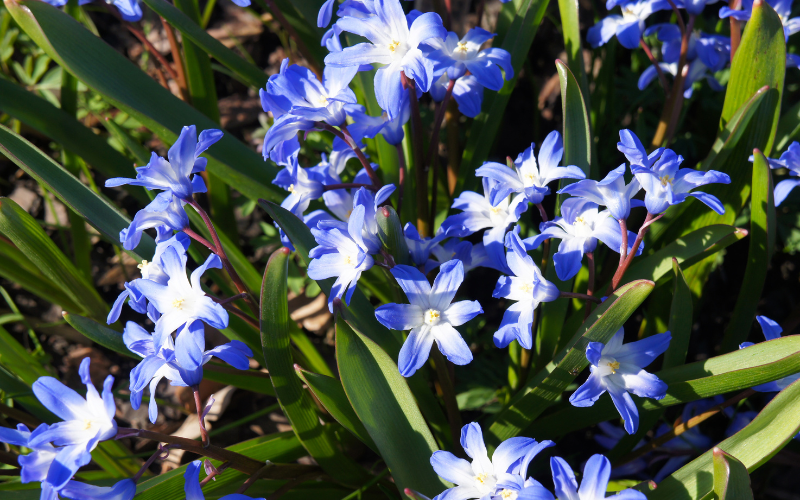
Glory-of-the-Snow is a small and charming bulbous plant in the Asparagaceae family. It is scientifically known as Chionodoxa. Glory-of-the-Snow are typically blue or purple, but they can also be found in shades of pink or white.
Glory-of-the-Snow bulbs are easy to grow and thrive in well-draining soil. They prefer full sun to partial shade and are often planted in rock gardens, borders, or woodland settings.
| Scientific Name | Chionodoxa luciliae |
| Native Range | Western Turkey |
| Flowering Season | Late spring to early summer |
Himalayan Blue Poppy
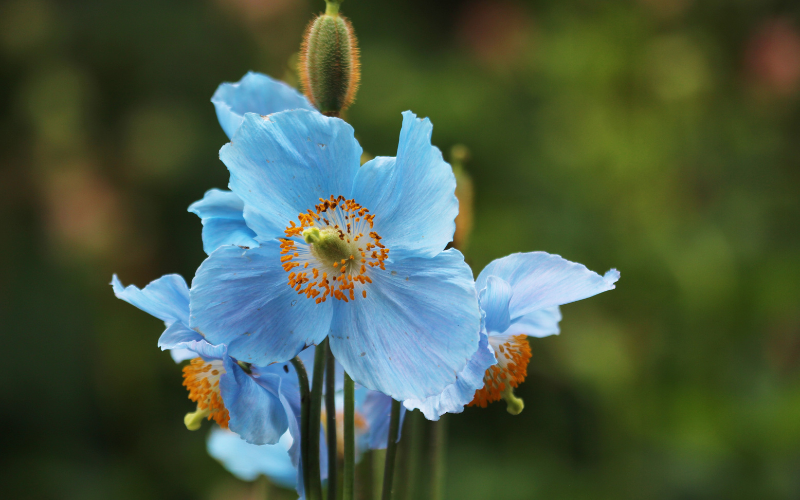
The Himalayan Blue Poppy is a stunning and unique flowering plant. It is scientifically known as Meconopsis betonicifolia. It is native to the eastern Himalayan region, particularly Bhutan, Nepal, and Tibet.
The flowers of the Himalayan Blue Poppy are large and cup-shaped, measuring about 3 to 4 inches (7.6 to 10 cm) across. They prefer cool, moist, and shady conditions, making them well-suited for woodland gardens with dappled sunlight.
| Scientific Name | Meconopsis betonicifolia |
| Native Range | Bhutan, Nepal, and TibetChina and Indo-China, Taiwan |
| Flowering Season | Late spring to early summer |
Jacob’s Ladder
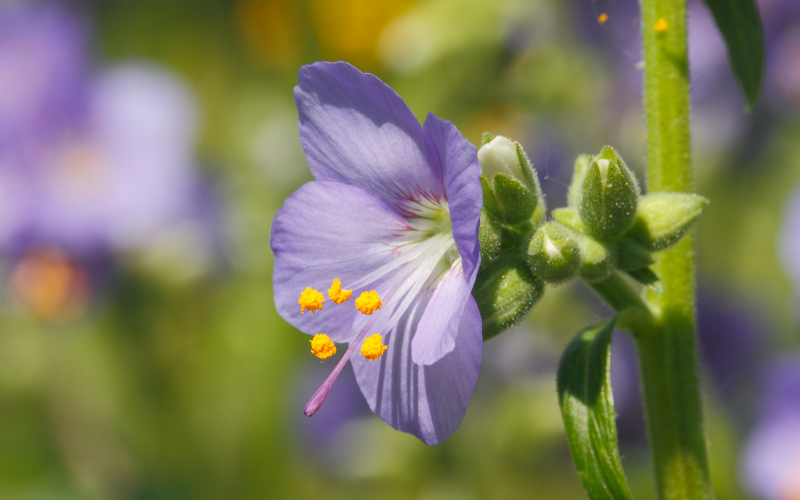
Jacob’s ladder is a charming flower. The plant typically reaches a height of about 12 to 24 inches (30 to 60 cm). The flowers of Jacob’s ladder appear in late spring to early summer.
It comes in a color range of blue, violet, or white in color. Jacob’s ladder prefers cool, temperate climates and does well in partial to full shade.
| Scientific Name | Polemonium |
| Native Range | Midwest, Appalachian, and Great Lakes regions |
| Flowering Season | Late spring to early summer |
Meadow Sage
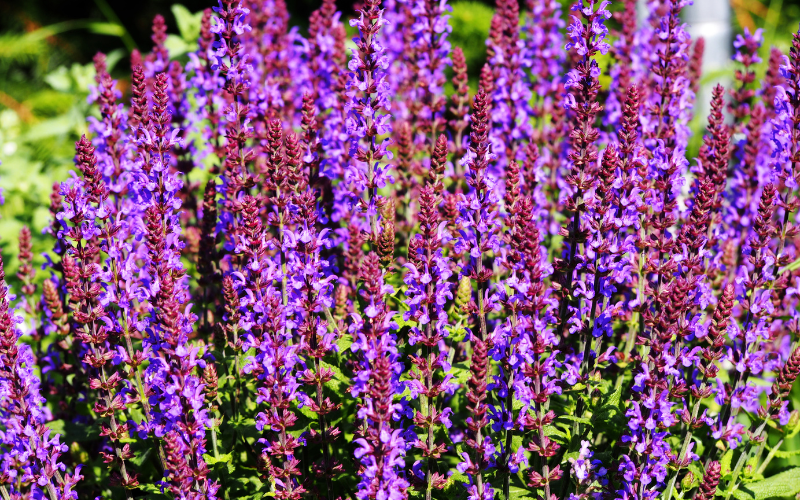
Meadow Sage is a beautiful flower. It is scientifically known as Salvia nemorosa. They come in a variety of colors, including shades of blue, purple, violet, pink, and white. Meadow Sage blooms profusely in late spring to early summer.
Meadow Sage is a hardy and adaptable plant that thrives in full sun but can tolerate light shade. It prefers well-drained soil and is relatively drought-tolerant once established.
| Scientific Name | Salvia pratensis |
| Native Range | Europe, Western Asia, and Northern Africa |
| Flowering Season | Summer |
Blue Flag Iris

The Blue Flag Iris flower is a mesmerizing flower. It is scientifically known as Iris versicolor. It is native to North America. The flowers are typically 2 to 4 inches (5 to 10 cm) in diameter and have a pleasant fragrance.
Blue Flag Iris typically blooms in late spring to early summer. It prefers consistently moist to wet soil and can even tolerate shallow water. Blue Flag Iris is relatively low-maintenance once established.
| Scientific Name | Iris versicolor |
| Native Range | United States |
| Flowering Season | Late spring to early summer |
Ageratum
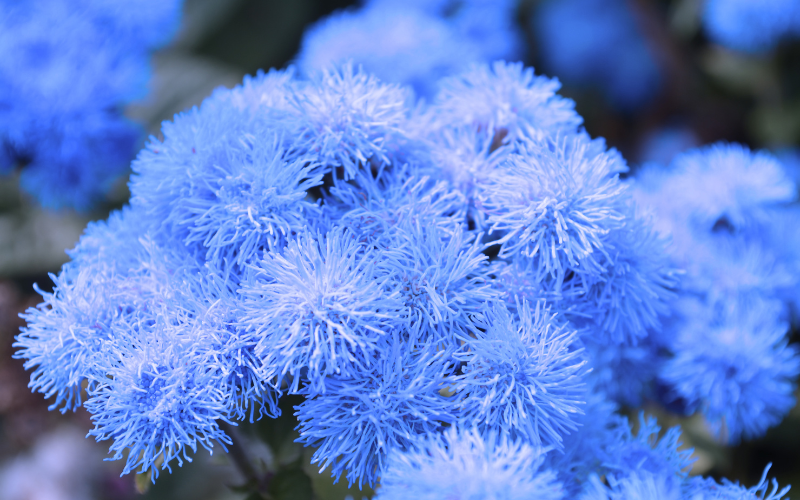
The Ageratum flower is a lovely flower. It is also known as Flossflower. Ageratum plants are compact and bushy, typically reaching heights of 6 to 24 inches (15 to 60 cm). These flowers come in various colors, including shades of blue, pink, purple, and white.
Ageratum is known for its continuous blooming throughout the summer and into the fall. Ageratum is relatively easy to grow. It prefers full sun to partial shade and well-drained soil.
| Scientific Name | Ageratum houstonianum |
| Native Range | Central America and Mexico |
| Flowering Season | Late spring through fall |
Canterbury Bells

Canterbury Bells is a beautiful flower. It is scientifically known as Campanula medium. Canterbury Bells typically grow as upright, bushy plants, reaching heights of 2 to 3 feet (60 to 90 cm).
They come in various colors, including shades of blue, purple, pink, and white. Canterbury Bells bloom in late spring to early summer. Canterbury Bells prefer full sun to partial shade. They thrive in well-drained soil with good organic content.
| Scientific Name | Campanula medium |
| Native Range | Europe |
| Flowering Season | Summer |
Japanese Iris
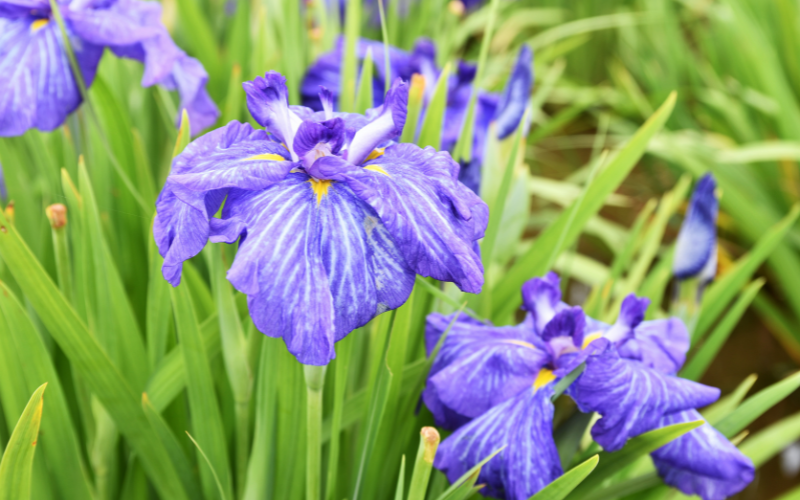
The Japanese Iris is a captivating and mesmerizing flower. It is scientifically known as Iris ensata. It is native to Japan. Japanese Iris plants typically reach a height of 2 to 4 feet (60 to 120 cm).
It comes in a wide range of colors, including shades of purple, blue, white, pink, and red. Japanese Irises typically bloom in late spring to early summer. Japanese Irises require regular moisture, so they are well-suited.
| Scientific Name | Iris ensata |
| Native Range | Japan, China, Korea and Russia |
| Flowering Season | Early to Mid-Summer |
Hyacinthoides
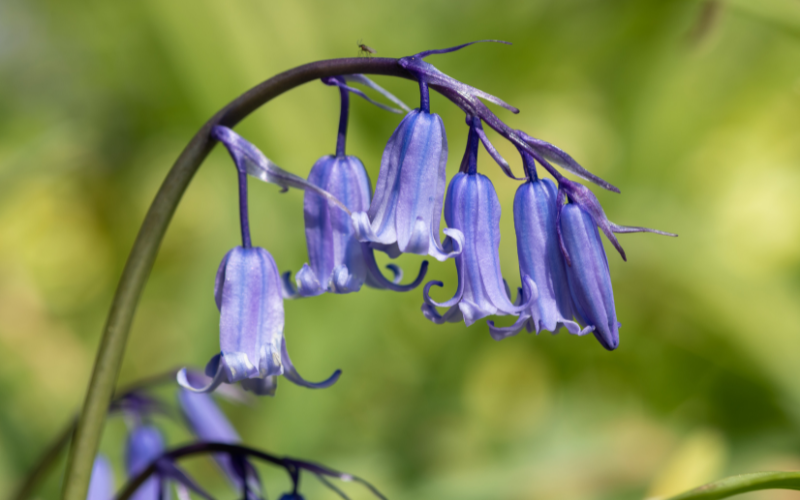
The Hyacinthoides is a stunning flower. It is native to Europe. It comes in colors violet-blue to deep blue, or even occasionally pink, flowers. Hyacinthoides typically bloom in spring.
The Hyacinthoides are relatively low-maintenance plants. They thrive in partial to full shade and well-drained soil.
| Scientific Name | Hyacinthoides |
| Native Range | Europe |
| Flowering Season | Late Spring |
Himalayan Bellflower

The Himalayan Bellflower is a beautiful flower. It is scientifically known as Campanula latifolia. It is native to the Himalayan region. The Himalayan Bellflower is a robust plant that typically reaches heights of 3 to 5 feet (90 to 150 cm).
Himalayan Bellflowers typically bloom in late spring to early summer. Himalayan Bellflowers successfully, provide them with full to partial sun and well-drained soil.
| Scientific Name | Campanula latifolia |
| Native Range | Asia |
| Flowering Season | Late spring to early summer |
Bluehead Gilia

The Bluehead Gilia flower is stunning. It is also known as Gilia capitata. It is native to North America, particularly the western United States and Mexico. The flower cluster can be 1 to 2 inches (2.5 to 5 cm) in diameter.
It is well-suited to areas with well-drained soil and receives plenty of sunlight. The Bluehead Gilia typically blooms in the spring and early summer.
| Scientific Name | Gilia capitata |
| Native Range | Western North America |
| Flowering Season | Late spring to early summer |
Phlox
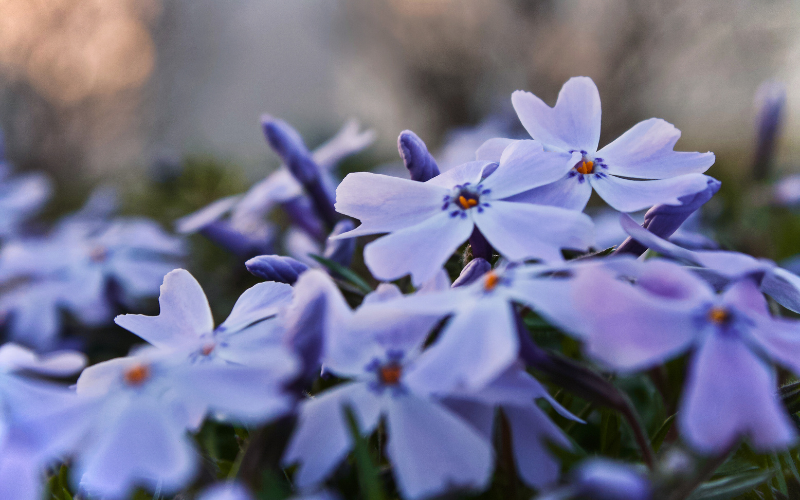
Phlox is a stunning flower. It is commonly known as “Garden Phlox” or “Phlox paniculata.” Phlox flowers come in a wide range of shades, including white, pink, purple, and blue.
Phlox plants typically grow as erect, bushy perennials, reaching heights of 2 to 4 feet. It is blooms during the late spring to early summer. They prefer full sun to light shade for optimal growth and flowering.
| Scientific Name | Phlox glaberrima |
| Native Range | North America |
| Flowering Season | Spring to Summer |
Blue Waterlily
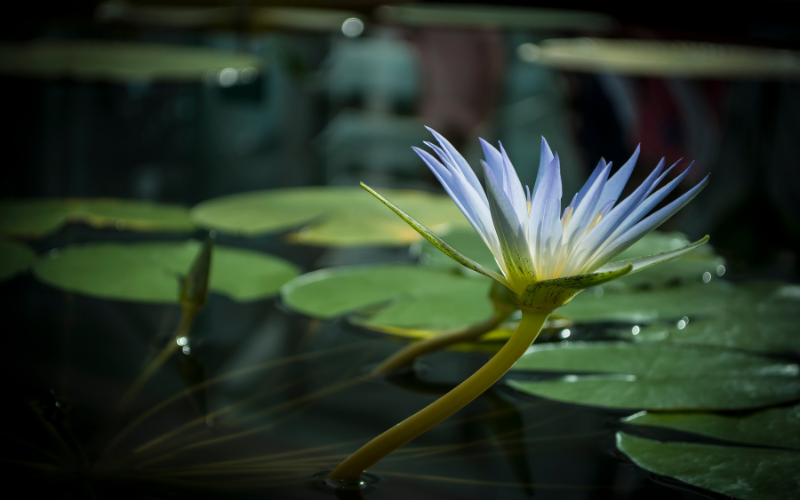
Blue Waterlily is a beautiful flower. It is scientifically known as Nymphaea caerulea or the “Blue Lotus.” It is native to Egypt. The center of the flower is typically yellow or yellow-green.
Blue Waterlily flowers often float gracefully on the water’s surface. Blue Waterlilies require a sunny location in a pond or water garden. They thrive in calm, shallow waters with temperatures between 75°F and 86°F (24°C to 30°C).
| Scientific Name | Nymphaea caerulea |
| Native Range | Northern and Central Africa |
| Flowering Season | Late spring, summer, and early autumn |
Blue-Eyed African Daisy
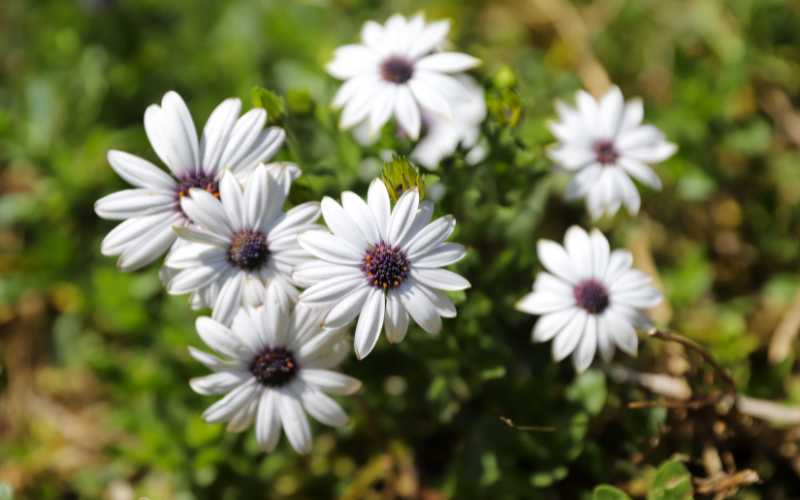
Blue-eyed African Daisy is a lovely flower. It is scientifically known as Arctotis stoechadifolia. It is native to South Africa. The flowers are typically a bright shade of orange or yellow, creating a lovely contrast with the striking blue or violet-blue centers, giving it the “blue-eyed” appearance.
This daisy is relatively easy to grow and is well-suited to sunny gardens with well-draining soil. It thrives in full sunlight and prefers regular watering.
| Scientific Name | Arctotis venusta |
| Native Range | South Africa |
| Flowering Season | Late spring to early fall |
Blue-Eyed Mary
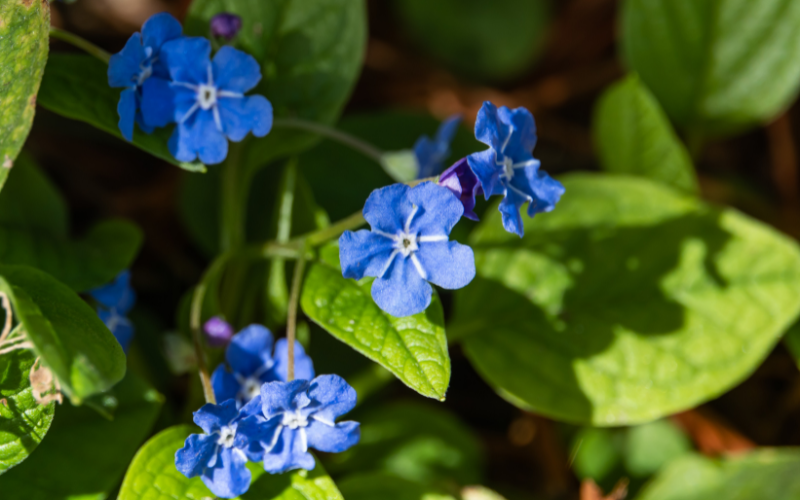
Blue-Eyed Mary is a gorgeous flower. It is scientifically known as Collinsia verna. It is native to western North America. It typically grows to a height of about 6 to 12 inches (15 to 30 cm).
The Blue-Eyed Mary boasts clusters of small, tubular-shaped blossoms that seem to glow in the sunlight. Blue-Eyed Mary is a relatively low-maintenance plant. It prefers well-draining soil and partial shade but can tolerate a variety of soil types.
| Scientific Name | Collinsia |
| Native Range | North America |
| Flowering Season | Mid-spring to Early summer |
Chinese Forget-Me-Not
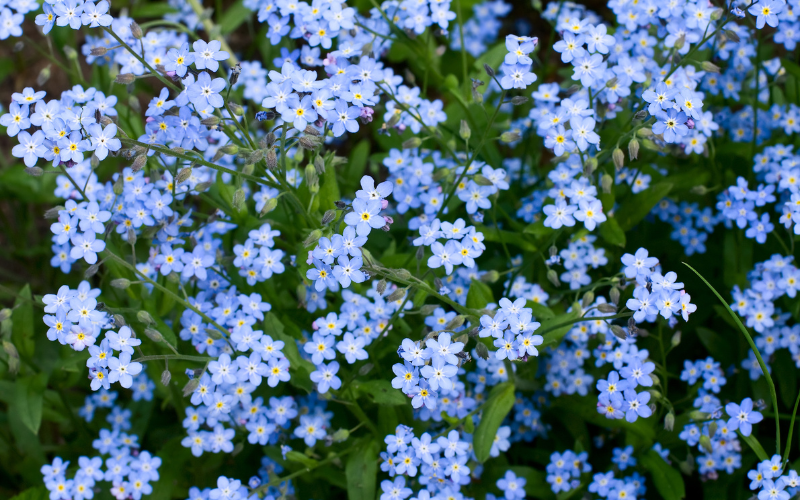
Chinese Forget-Me-Not is a beautiful flower. It is scientifically known as Cynoglossum amabile. It is native to China. Chinese Forget-Me-Not is a compact and bushy plant that typically reaches a height of 12 to 24 inches (30 to 60 cm).
It thrives in sunny to partially shaded areas and well-draining soil. Chinese Forget-Me-Not is a popular choice for garden borders, containers, and wildflower meadows.
| Scientific Name | Cynoglossum amabile |
| Native Range | East Himalayas, Nepal, Thailand, Tibet, China |
| Flowering Season | Early summer through the first frost in fall |
Blue Pimpernel
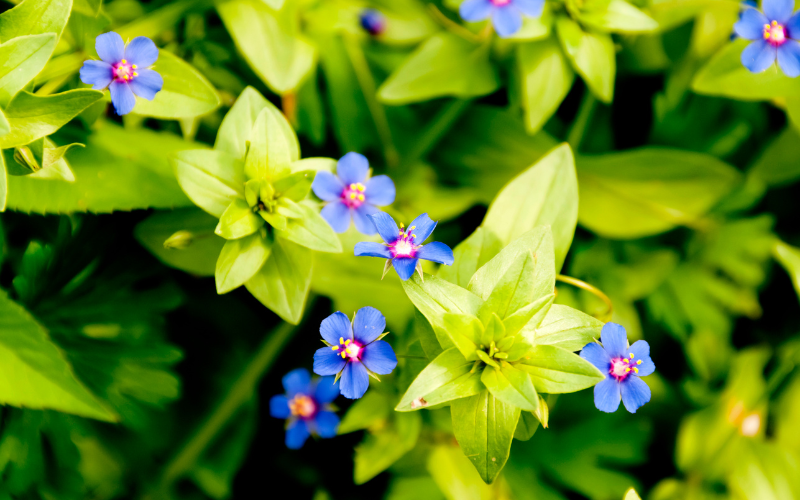
The Blue Pimpernel is a stunning flower. It is scientifically known as Anagallis arvensis. It is native to Europe. These five-petaled flowers are typically about 0.5 inches (1.3 cm) in diameter. The Blue Pimpernel has a short blooming period, typically from late spring to early summer.
It prefers well-drained soils and is known for its ability to thrive in sandy or gravelly soils. The Blue Pimpernel flower adds a touch of elegance and charm to any outdoor space.
| Scientific Name | Anagallis arvensis |
| Native Range | Mediterranean region |
| Flowering Season | Early summer to early autumn |
Blue Bellflower
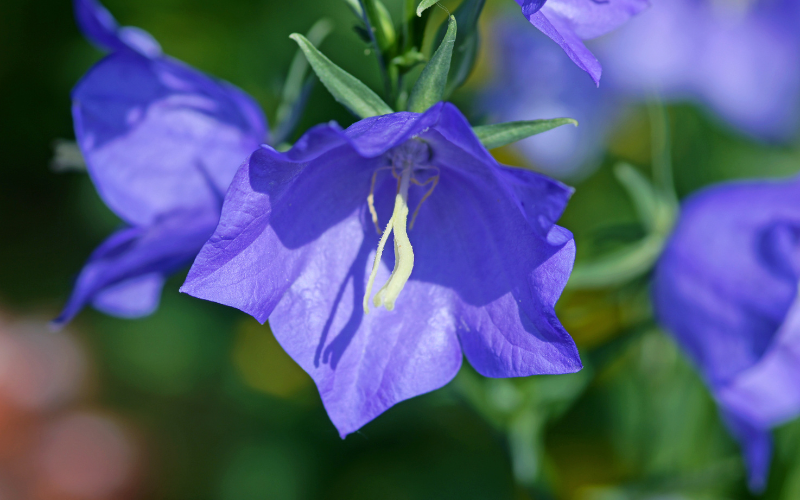
Blue Bellflower is a beautiful flower. It is scientifically known as Campanula rotundifolia. It is native to Europe and North America. The flowers are typically about 0.5 inches (1.3 cm) in diameter.
Each flower has a small, contrasting center with a yellow or blackish eye. It prefers well-drained soils and is known for its ability to thrive in sandy or gravelly soils. It prefers full sun to partial shade and doesn’t require particularly rich soil.
| Scientific Name | Campanula rotundifolia |
| Native Range | Europe and North America |
| Flowering Season | Late spring to summer |
Bachelor’s Button
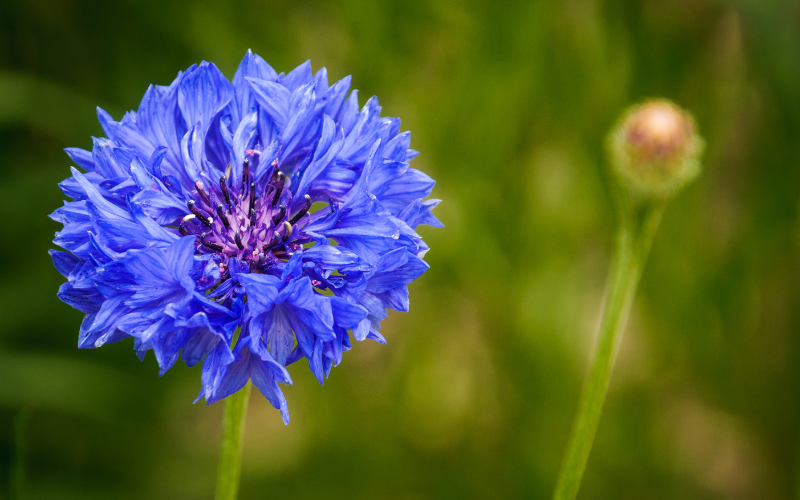
Bachelor’s Button is a charming flower. It is scientifically known as Campanula rotundifolia. It is native to Europe and Asia but has also naturalized in North America. These charming flowers have five petals fused at the base and are about 0.5 to 1 inch (1.3 to 2.5 cm) long.
They thrive in well-drained soils and are often seen in cooler, temperate regions. Blue Bellflowers are relatively easy to grow from seeds.
| Scientific Name | Centaurea cyanus |
| Native Range | Europe |
| Flowering Season | Early Summer until the Frost |
Spiderwort
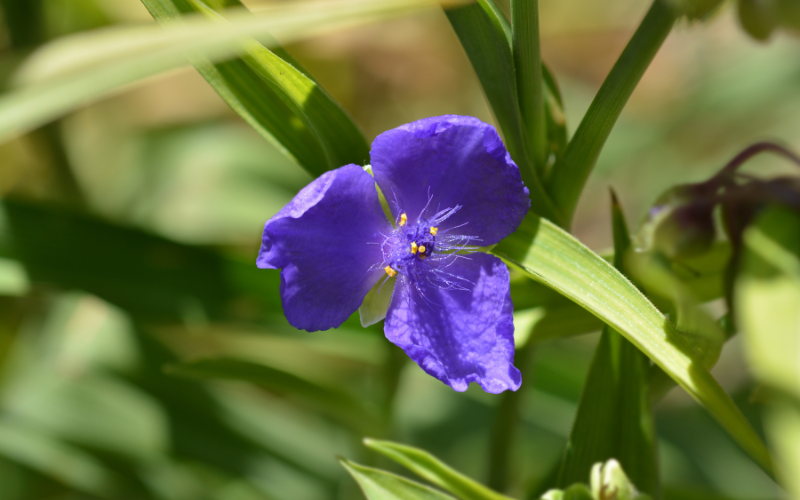
Spiderwort is a mesmerizing flower. It is scientifically known as Centaurea cyanus. It is native to Europe. Each flower head is about 1 to 1.5 inches (2.5 to 3.8 cm) in diameter. The flowers of the Spiderwort come in an array of captivating colors, including shades of purple, pink, blue, and white.
Spiderwort is a low-maintenance plant that thrives in a variety of soil conditions and is relatively resistant to pests and diseases.
| Scientific Name | Tradescantia |
| Native Range | United States |
| Flowering Season | Late spring to early summer |
Plumbago
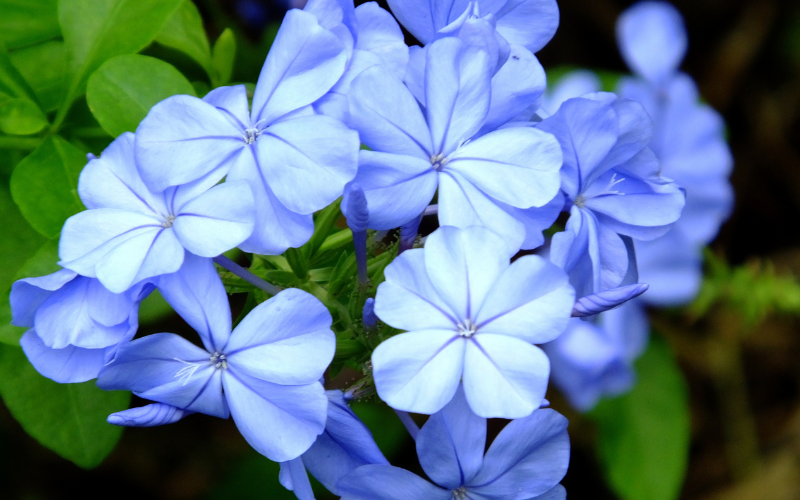
Plumbago is a beautiful flower. It is also known as Leadwort or Ceratostigma. It is native to several regions, including parts of Asia, Africa, and the Americas. It is a woody plant that typically grows to a height of 2 to 3 feet (60 to 90 cm). The flowers can be either sky blue or white, depending on the variety.
It thrives in full sun to partial shade and prefers well-drained soil. Plumbago is a popular choice for garden borders, ground covers, and container gardens.
| Scientific Name | Plumbago |
| Native Range | United States |
| Flowering Season | Late spring to early summer |
Question & Answer
What is the importance of blue flowers?
Blue is often associated with calmness, serenity, and tranquility. Blue flowers can evoke a sense of peace and relaxation, making them popular choices for creating soothing and peaceful environments.
What do blue flowers attract?
Bees are attracted to blue flowers because they can see the color blue more distinctly than other colors
Is Blue Flower edible?
While some blue flowers are edible, some may be toxic or have negative side effects if consumed.
What is the blue flower used for cooking?
One blue flower commonly used for culinary purposes is the “butterfly pea flower” (Clitoria ternatea).
What is blue flower tea called?
The blue flower tea is commonly known as “butterfly pea flower tea.” It is made from the petals of the butterfly pea flower (Clitoria ternatea).
